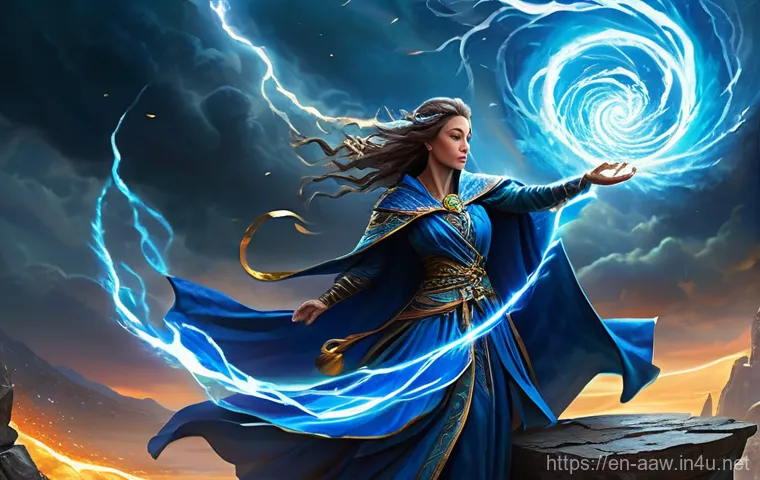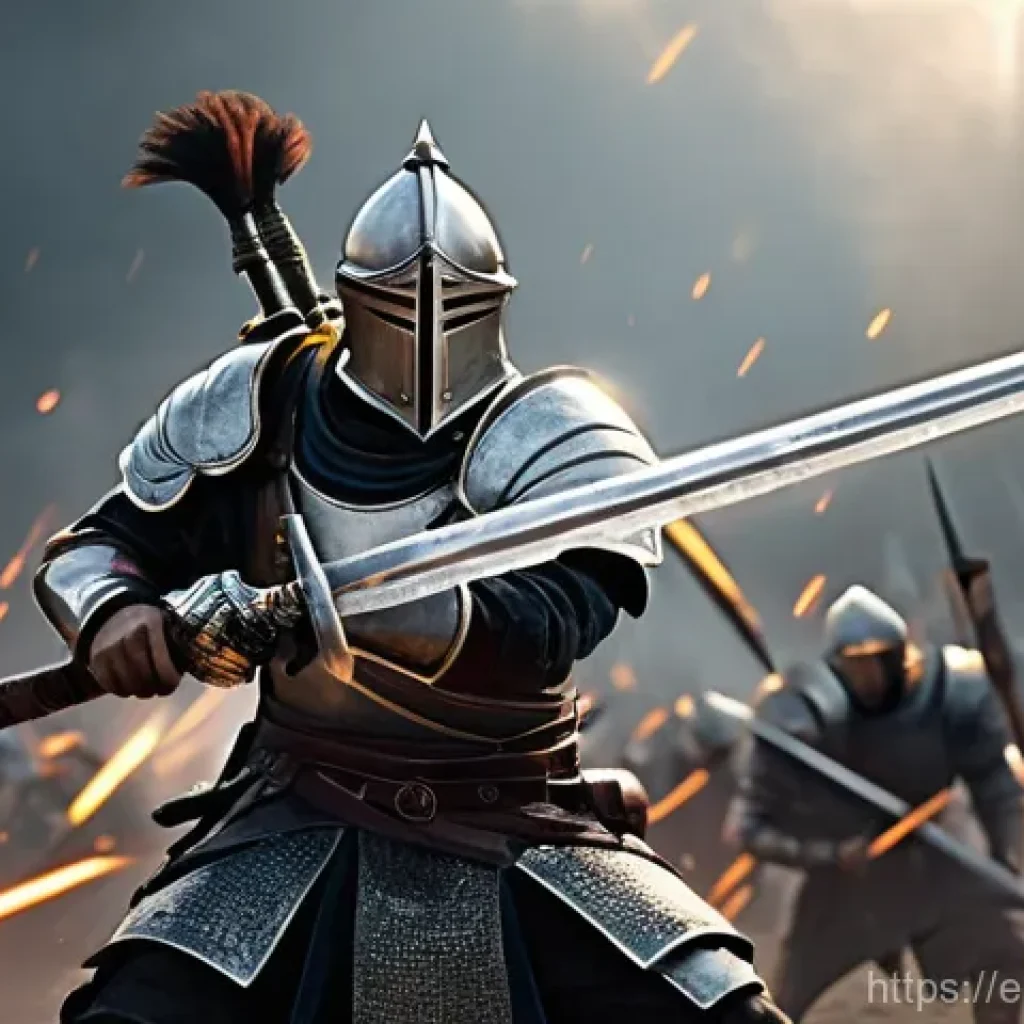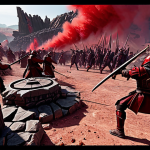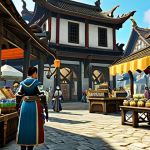Let’s be real, navigating the vast world of ArcheAge and truly mastering your class setup can feel like an endless quest in itself, right? After countless hours spent theorycrafting, battling it out in intense PvP, and experimenting with every patch, I’ve seen firsthand how a truly optimized build can transform your gameplay from frustrating to absolutely exhilarating.
The meta is constantly shifting, with each update bringing new challenges and opportunities for dominance, and staying ahead of that curve is crucial for anyone looking to truly shine.
If you’re tired of feeling outmatched or just want to truly unleash your character’s full potential, you’re in the perfect spot. I’ve personally distilled all that knowledge and practical application into battle-tested strategies that are truly game-changers.
Ready to elevate your game and dominate every encounter? Let’s dive deep into the absolute top-tier ArcheAge class settings right here, right now!
The Unstoppable Melee Marauder: Crushing Foes Up Close

There’s nothing quite like charging headfirst into the fray, knowing your build can withstand the punishment and dish out even more. My personal journey through countless PvP skirmishes and dungeon crawls in ArcheAge has shown me time and again that a well-tuned melee brawler isn’t just about raw damage; it’s about timing, tenacity, and an almost intuitive understanding of your opponent’s weaknesses. I remember one particularly intense arena match where I was staring down a seemingly unkillable healer, and my finely-tuned Darkrunner build, with its devastating burst and surprisingly robust survivability, allowed me to break through their defenses where others had failed. It’s an exhilarating feeling, truly, to watch an enemy’s health bar melt away under a flurry of perfectly executed abilities. This isn’t just theory for me; it’s the result of hours spent tweaking stats, experimenting with weapon types, and even diving deep into the nuances of armor penetration versus raw attack power. Trust me, the difference between a good melee build and a truly great one often lies in those subtle, often overlooked details that can turn a close fight into a decisive victory. It’s a constant dance of aggression and self-preservation, and mastering that rhythm is what separates the legends from the hopefuls.
Core Skill Synergies for Brutal Damage
When you’re building a melee monster, it’s all about creating devastating combos that chain together seamlessly. For me, the absolute cornerstone almost always involves skill trees like Battlerage and Shadowplay, often paired with Defense or Auramancy for that critical survivability and utility. Think about it: Battlerage gives you those hard-hitting skills like Triple Slash, Charge, and Whirlwind Slash, which are fantastic for cleaving through groups or focusing down a single target. But here’s the kicker – pairing them with Shadowplay’s Shadow Step or Overwhelm provides invaluable gap-closers, stuns, and even critical damage bonuses that elevate your burst potential to insane levels. I’ve found that meticulously planning out your engagement sequence, like using Charge to trip an enemy and then immediately following up with Overwhelm for a further stun and a guaranteed critical hit, is what truly defines a top-tier melee player. It’s not just mashing buttons; it’s a strategic dance of death, and understanding these interactions is your ticket to dominating the battlefield. Every single global cooldown counts, and optimizing how your skills interact can mean the difference between getting a kill and being reset to your spirit healer.
Tanking the Hits: Survivability in the Fray
Let’s be real, you can’t deal damage if you’re dead. This is where the often-underestimated aspect of melee survivability comes into play. While raw damage numbers are flashy, a truly effective brawler knows how to stay alive long enough to deliver that damage. I’ve personally experimented with various third skill trees to bolster my defenses, with Defense and Auramancy often coming out on top. Defense offers incredible mitigation with skills like Boastful Roar and Redoubt, which can absorb immense amounts of incoming damage, especially when you’re caught in a tight spot. On the other hand, Auramancy provides crucial magic defense and crowd control breaks with Conversion Shield and Shrug It Off, which are absolute lifesavers against those pesky mages and archers. Finding that sweet spot between offense and defense isn’t always easy, and it often comes down to your preferred playstyle and the current meta you’re facing. For instance, if you’re constantly running into heavy magic damage, prioritizing Auramancy for its dispels and magic defense buffs is a no-brainer. If you’re tanking hits in a siege, Defense’s raw physical damage reduction is king. The goal is always to maximize your uptime in combat, ensuring you’re a persistent threat rather than a fleeting moment of burst.
Whispers of Death: Mastering the Stealth Assassin
Few things in ArcheAge are as satisfying as stalking your prey from the shadows, striking with precision, and vanishing before they even know what hit them. I’ve spent countless hours honing my skills as an assassin, learning the intricate dance of stealth, burst, and escape. It’s not just about ambushing; it’s about psychological warfare, forcing your opponents to constantly look over their shoulders. There was this one time, during a hotly contested trade run, where my guild was ambushed by a superior force. While the main battle raged, I managed to peel off and systematically eliminate their healers and ranged damage dealers one by one, completely tipping the scales in our favor. It felt like I was playing a completely different game than everyone else, a ghost in the machine. This playstyle demands patience, an intimate knowledge of the map, and an almost psychic ability to predict enemy movements. Trust me, getting caught out of position as a stealth assassin is a swift trip to the respawn point, so every move has to be calculated, every ability perfectly timed. It’s a high-risk, high-reward approach, but when executed flawlessly, it’s undeniably one of the most impactful and exhilarating ways to play ArcheAge. The thrill of the hunt and the clean kill is truly unparalleled.
The Art of the Perfect Gank: Opening Combos
For an assassin, the opening move is everything. Your goal is to eliminate your target as quickly as possible, ideally before they can react. Shadowplay is, without a doubt, your bread and butter here. Skills like Stealth, Stalkers Mark, and Overwhelm are your core toolkit. I typically start with a well-placed Stalkers Mark, immediately followed by Stealth to close the distance undetected. Then, once I’m in melee range, a devastating Overwhelm will stun the target, allowing me to unleash a torrent of damage from Battlerage or Archery skills. For instance, a common and incredibly potent combo involves marking the target, stealthed approach, Overwhelm, then a quick Shadowsmite for additional stun duration and damage, followed by Triple Slash or Rapid Shot. The key is to maximize the time your target is immobilized or debuffed, ensuring every subsequent hit lands with maximum impact. I’ve seen countless players panic and waste their break-free abilities too early, and that’s exactly when you double down and seal their fate. It’s a precise art, and every second counts in that initial burst.
Escaping the Shadows: Disengage and Control
What good is a perfect gank if you can’t get away to tell the tale? A master assassin isn’t just about the kill; it’s about survival and setting up the next kill. Shadowplay again shines here with invaluable disengage tools. Drop Back, Flicker, and even a well-timed Shadow Step can get you out of sticky situations in a heartbeat. I’ve personally relied on a quick Drop Back combined with Flicker to create massive distance after a successful assassination, often leaving my pursuers bewildered and frustrated. Auramancy can also be a fantastic pairing, offering Teleportation and Shrug It Off to break out of crowd control and reposition. The ability to quickly reset and re-stealth allows you to either re-engage on a vulnerable target or simply escape to safety, preserving your killstreak and your gear. Remember, you’re not meant to stand and brawl after your initial burst; you’re a surgical strike force. My advice? Practice those escape routes as much as you practice your opening combos. Knowing when to disengage is a critical skill that truly elevates your assassin gameplay from good to truly legendary. Always have an exit strategy ready!
Arcane Overload: Unleashing Magical Catastrophe
Oh, the sweet, sweet sound of a perfectly cast Meteor showering down on unsuspecting enemies! As someone who has spent a considerable amount of time weaving spells and commanding elemental forces in ArcheAge, I can tell you there’s a unique joy in being the mage, the one who dictates the flow of battle from a distance with raw, unadulterated magical power. It’s not just about flashy explosions, though those are definitely a perk; it’s about intelligent positioning, timing your crowd control, and managing your mana pool like a hawk manages its prey. I’ve had moments in massive guild vs. guild battles where a single well-placed Gods’ Whip or Arc Lightning completely turned the tide, decimating entire groups of enemies. It feels like you’re holding the power of a natural disaster in your hands! But don’t be fooled by the grandeur; being a top-tier mage requires a deep understanding of counter-play, knowing when to commit to a cast, and when to conserve your resources. It’s a delicate balance of aggression and caution, and when you get it right, the results are nothing short of spectacular. The sheer satisfaction of seeing multiple enemies fall to your spells is incredibly addictive, and it’s a playstyle I always come back to when I want to feel truly powerful.
Burst Potential and Mana Management
A mage lives and dies by their burst. Sorcery is obviously the cornerstone here, with powerhouse abilities like Meteor, Flamebolt, and Chain Lightning forming the backbone of your offensive toolkit. What I’ve found, however, is that while raw spell damage is important, effective mana management and understanding casting priorities are what truly elevate your game. Nothing is worse than running out of mana mid-fight, leaving you a sitting duck. That’s why I often pair Sorcery with Vitalism or even Witchcraft for their mana recovery and sustain options. Skills like Insulating Lens (from Vitalism) can provide a much-needed shield and mana regeneration, while Witchcraft’s Earthen Grip not only offers crowd control but can also allow a brief moment to regenerate mana. It’s about finding that rhythm where you’re constantly casting, constantly dealing damage, but never dipping into critical mana levels. My go-to burst rotation often starts with a crowd control spell from Witchcraft or a quick Freezing Earth to set up targets, followed by a rapid succession of Flamebolts and then a big finisher like Meteor or Gods’ Whip. Learning to cancel casts to conserve mana or bait out abilities is also a pro-tip I swear by – it’s a subtle move that can make a huge difference in drawn-out engagements.
Countering the Casters: Positioning and Protection
As a mage, you’re often a prime target. Glass cannons, as they say, tend to shatter if not protected. This means smart positioning and understanding how to protect yourself are absolutely crucial. I’ve learned the hard way that standing still in the middle of a chaotic fight is an express ticket back to the nearest Nui statue. Auramancy is a fantastic companion skill tree for mages, providing crucial defensive and escape tools. Teleportation is your best friend, allowing you to quickly reposition, escape incoming attacks, or even chase down fleeing enemies. Shrug It Off and Conversion Shield are vital for breaking out of enemy crowd control and boosting your magic defense against opposing casters. I always make sure to keep an eye on enemy movement and line of sight, using terrain and my allies as shields whenever possible. It’s not about being cowardly; it’s about strategic survival. Remember, a living mage can cast spells; a dead one can’t. My personal tactic in large-scale PvP often involves staying on the edges of the main conflict, dropping my most potent area-of-effect spells, and then quickly repositioning with Teleportation to avoid being focused down. It’s a constant mental game of threat assessment and spatial awareness.
The Sentinel’s Watch: Precise Ranged Execution
There’s a quiet satisfaction that comes with being an archer in ArcheAge, standing at a distance, meticulously lining up shots, and watching your arrows find their mark with devastating precision. I’ve always been drawn to the tactical side of ranged combat – it’s less about brute force and more about calculated movements, intelligent positioning, and understanding the ebb and flow of the battlefield from a vantage point. There was this one time during a deep-sea fishing raid, our ship was under attack from multiple angles. While the melee guys were holding the line, I found myself systematically disabling the enemy’s siege weapons and picking off their healers from the crow’s nest. It felt like I was the eye in the sky, orchestrating chaos from afar. It’s an incredibly rewarding playstyle, but it demands an almost zen-like focus to maintain distance, manage your cooldowns, and constantly assess threats. You’re often the first target for enemy assassins, so your awareness and ability to create space are paramount. Trust me, it’s not for the faint of heart; but for those who master it, the ability to control the pace of a fight and dictate terms from a safe distance is truly empowering. It’s a thinking player’s game, and the rewards are immense when your shots consistently land.
Kiting and Positioning for Maximum Impact
As an archer, your mobility is your lifeblood. Archery skills are fantastic for damage, of course, with Endless Arrows, Charged Bolt, and Snipe forming the core of your offensive output. But what truly sets a great archer apart is their ability to kite – continuously move and attack, keeping enemies at arm’s length. Shadowplay is almost a mandatory pairing for this, offering Drop Back and Flicker for instant distance creation. I’ve personally perfected a rhythm of firing a few shots, then using Drop Back to create space while simultaneously firing another volley, then following up with Flicker if the enemy is still too close. Auramancy also comes into play with Teleportation, giving you even more options for evasion and repositioning. The key is to never be stationary for too long, always be on the move, and constantly assess where your enemies are and where they want to be. I remember one specific encounter where a ganker almost had me cornered, but a perfectly timed Teleportation over a small ledge completely broke their pursuit, giving me enough time to turn around and finish them off. It’s all about making the battlefield your playground and dictating the terms of engagement.
Utility and Crowd Control from a Distance
An archer isn’t just a damage dealer; you’re also a critical source of utility and crowd control from afar. While your primary role might be to pepper enemies with arrows, knowing when and how to apply debuffs or slow down pursuers can turn the tide of a skirmish. Archery itself offers some fantastic tools like Concussive Arrow, which can silence a pesky mage, or Deadeye for a significant boost to damage at the cost of mobility. However, combining these with other skill trees truly unlocks your potential. Occultism, for example, provides amazing crowd control with Hell Spear and Crippling Mire, allowing you to lock down multiple targets or slow down an entire advancing front. Witchcraft offers Bubble Trap for an instant aerial crowd control or Lassitude to put enemies to sleep. I’ve found that a well-placed Bubble Trap on an approaching melee DPS can completely disrupt their engage and give my team the precious seconds needed to turn the fight. It’s about knowing your toolkit and using the right arrow for the right situation. Don’t underestimate the power of a perfectly timed stun or slow from a distance; it can save lives and secure kills just as effectively as raw damage.
| Archetype | Key Skill Trees | Primary Role | Common Strengths | Common Weaknesses |
|---|---|---|---|---|
| Melee DPS | Battlerage, Shadowplay, Defense/Auramancy | High burst damage, Frontline engagement | Excellent mobility, Strong 1v1 potential, Good cleave | Vulnerable to crowd control, Can be kited by ranged, High gear dependency |
| Ranged DPS | Archery, Shadowplay, Auramancy | Consistent damage from afar, Kiting | High mobility, Good crowd control, Safe damage output | Squishy, Can be focused down by melee, Requires good positioning |
| Mage DPS | Sorcery, Witchcraft, Auramancy/Occultism | Massive AoE damage, Single-target burst, CC | Devastating area control, High burst, Strong crowd control | Long cast times, Vulnerable to interrupts, Mana intensive |
| Tank | Defense, Auramancy, Vitalism/Battlerage | Frontline leader, Damage mitigation, Taunting | High survivability, Excellent crowd control, Protects allies | Low damage output, Can be kited, Reliant on team for damage |
| Healer/Support | Vitalism, Auramancy, Songcraft/Defense | Healing, Buffing, Debuffing, CC | Crucial for team sustain, Strong dispels, Area-of-effect buffs | Low damage, High mana cost, Priority target for enemies |
The Shielded Healer: Keeping Your Allies in the Fight

Let’s be honest, without a dedicated healer, even the most powerful DPS builds will crumble. My time spent as a healer in ArcheAge has taught me that this role is perhaps the most selfless, yet also one of the most impactful. There’s an immense pressure, certainly, but the satisfaction of seeing your allies survive seemingly impossible situations because of your quick reactions and smart heals is truly unparalleled. I recall a particularly harrowing boss fight in a raid where our main tank went down, and through a combination of timely heals, buffs, and even a few well-placed crowd controls, I managed to keep the off-tank alive just long enough for the main tank to get revived. It was chaotic, intense, and utterly rewarding. Being a top-tier healer isn’t just about spamming your heal button; it’s about anticipating damage, understanding threat levels, and knowing when to peel for your allies, even if it means putting yourself at risk. It’s a constant mental chess game, always thinking three steps ahead, and when you nail it, you become the indispensable backbone of any successful group. Truly, a skilled healer often separates victory from defeat, and for me, that responsibility is what makes the role so incredibly engaging.
Prioritizing Heals and Dispels
As a healer, your primary job is simple: keep your allies alive. Vitalism is, of course, your core skill tree, with essential abilities like Healing Hymn, Mend, and Revitalizing Cheer. However, what often separates a good healer from a truly exceptional one is the ability to prioritize and effectively dispel. I’ve personally found that in large-scale PvP or intense boss fights, anticipating incoming damage and pre-casting heals can save lives before the health bar even drops. Furthermore, knowing which debuffs to dispel immediately – like a fear, stun, or silence on your main tank or primary damage dealer – is absolutely critical. Auramancy is an invaluable secondary tree for healers, providing Shrug It Off and Conversion Shield to not only break yourself free from crowd control but also to apply crucial magic defense buffs. I always keep a close eye on my raid frames, quickly identifying who is taking the most damage and who is afflicted by debilitating debuffs. It’s a high-pressure situation, but making those split-second decisions correctly can turn a losing fight into a comeback victory. The power of a perfectly timed dispel is often overlooked, but it’s a genuine game-changer.
When to Engage: Offensive Support Tactics
While healing is your main priority, a truly masterful support player knows when to transition from pure healing to offensive support. It’s not about being a damage dealer, but about utilizing your utility to swing the fight in your favor. Often, this involves using crowd control abilities to lock down key enemy targets or applying crucial buffs to your allies. Songcraft, for example, is an incredible tree for offensive support, offering powerful area-of-effect buffs like Bloody Chantey and Quickstep, which can significantly boost your team’s damage and mobility. I’ve personally seen moments where a well-timed Dissonant Psalm from Songcraft completely debuffed an enemy frontline, allowing our DPS to tear through them. Witchcraft also provides excellent offensive crowd control with Earthen Grip, Bubble Trap, and Fear, which can be used to peel for your damage dealers or set up kills. The trick is knowing when it’s safe to cast these abilities without compromising your healing output. It’s a fine line, but one that can greatly enhance your team’s overall effectiveness. My personal rule of thumb is: if everyone is relatively healthy and there’s a clear opportunity to CC a high-priority enemy, go for it! But always, *always* prioritize keeping your team alive above all else.
The Unyielding Defender: Frontline Fortitude
If you enjoy being the unmovable object, the bedrock upon which your team stands, then mastering the tank role in ArcheAge is probably your calling. I’ve spent countless hours absorbing blows, taunting bosses, and generally being the most annoying obstacle for enemy players, and honestly, it’s a blast. There’s a profound sense of responsibility, knowing that your survival directly impacts the success of your entire group. I vividly recall one massive siege where our keep’s gate was about to fall, and I, as the primary tank, stood firm, soaking up an incredible amount of damage and keeping the enemy focused on me while our mages unleashed their devastation. It felt like I was personally holding back the tide! This role isn’t about flashy numbers; it’s about pure resilience, clever positioning, and an unwavering commitment to protecting your allies. It demands a deep understanding of threat generation, damage mitigation, and when to use your defensive cooldowns. Trust me, nothing is more frustrating than a tank who can’t hold aggro or dies too quickly, so perfecting this role makes you absolutely indispensable. When done right, you become the living shield that allows your team to achieve victory.
Aggro Management and Damage Mitigation
For a tank, holding aggro and mitigating damage are the twin pillars of your existence. Defense is your absolute core skill tree, providing essential abilities like Boastful Roar for threat generation, Redoubt for physical defense, and Invincibility for those oh-crap moments. I’ve learned that effective aggro management isn’t just about spamming taunts; it’s about anticipating when and where enemies will switch targets and having your tools ready. For instance, in a multi-mob pull, I often use a quick Shield Slam to stun a priority target, followed by a Boastful Roar to catch all surrounding enemies. Auramancy is an excellent secondary tree, providing Shrug It Off to break out of enemy crowd control and Protective Wings for crucial magic damage reduction for yourself and your allies. My personal experience has shown me that layering your defensive cooldowns is vital – don’t blow everything at once unless absolutely necessary. Knowing when to pop Redoubt, or when to call for an external shield from a healer, is a skill that comes with practice and a deep understanding of the fight mechanics. It’s a constant mental calculation of incoming damage versus available defenses, and getting that balance right is pure gold.
Essential Gear for Unbreakable Defense
Your gear as a tank is arguably more critical than for almost any other role. You’re expected to absorb immense amounts of punishment, so your equipment choices directly impact your effectiveness. When I’m gearing up a tank, my absolute priority is almost always maximizing physical and magical defense, along with a healthy pool of HP. This usually means heavy armor, often with a shield, and specific gemming choices. Look for items that boost Stamina, Toughness, and Resilience. Stamina directly increases your health pool, making you harder to kill. Toughness reduces incoming damage from all sources, while Resilience reduces the chance of critical hits and the bonus damage from them – absolutely crucial in PvP! I’ve found that even a small increase in Resilience can make a noticeable difference against bursty DPS builds. Beyond just stats, specific set bonuses from crafted armor or dungeon drops can provide invaluable defensive procs or stat boosts that synergize perfectly with your role. Don’t skimp on your defensive accessories either; rings and earrings that provide flat defense or health are often far more valuable than a slight damage increase. Remember, your job is to stay alive, and your gear should reflect that singular purpose. Investing in defensive gear isn’t just for you; it’s an investment in the survival of your entire team, and trust me, they’ll thank you for it!
The Versatile Vanguard: Hybrid Warfare Unleashed
Sometimes, being locked into a single role just doesn’t cut it, right? That’s where the beauty of hybrid builds in ArcheAge truly shines. I’ve always been fascinated by the idea of being a jack-of-all-trades, a master of none but capable of filling any gap in a team. This isn’t just about being okay at everything; it’s about intelligently blending skill trees to create synergies that offer unique advantages in dynamic combat situations. I remember one particularly challenging open-world skirmish where our group was constantly adapting to changing enemy compositions. My Blighter build, a blend of Battlerage, Defense, and Shadowplay, allowed me to switch between being a front-line bruiser, a stealthy ganker, or even a temporary off-tank, depending on what the situation demanded. It felt incredibly liberating to not be confined to a single role, truly. This playstyle demands a deeper understanding of all three of your chosen skill trees and the ability to make rapid, on-the-fly decisions about how best to contribute. It’s for the players who love strategic depth, who enjoy outsmarting their opponents with unexpected shifts in combat roles. Trust me, when you pull off a successful hybrid play, the satisfaction of adapting and overcoming is truly a high point in ArcheAge gameplay.
Balancing Offense and Support
The core challenge of a hybrid build is striking that perfect balance between dealing damage and providing essential support. It’s a delicate dance, often requiring you to re-evaluate your role mid-fight. Take a Paladin, for example – a fantastic blend of Battlerage, Defense, and Vitalism. You have the melee damage and survivability of Battlerage and Defense, but then you also bring crucial healing and dispels from Vitalism. I’ve personally found that in these builds, it’s not about doing everything at 100% capacity, but about doing what’s *needed* at that exact moment. If your healer is CC’d, you step in with a quick Mend. If an enemy is low, you switch to your Battlerage combo. Another great example is the Abolisher (Battlerage, Defense, Auramancy), which offers incredible frontline presence, damage, and vital crowd control breaks for itself and potentially nearby allies. The key is to optimize your gear and skill points to support both aspects effectively. This often means carefully selecting passives that benefit multiple roles and being proficient with both offensive and defensive rotations. My advice is to practice target prioritization and quick ability switching, so you can fluidly transition between roles without missing a beat. It’s truly a testament to your versatility as a player.
Adapting Your Build for Any Challenge
The true power of a hybrid build lies in its adaptability. You’re not rigid; you’re fluid, able to pivot your strategy as the combat situation evolves. This often means having different sets of gear or even different hotkey setups for various scenarios. For instance, as a Swiftblade (Shadowplay, Battlerage, Swiftblade), you have immense burst damage and mobility. But adding something like Defense or Auramancy can turn you into a much more resilient duelist or even an effective off-tank if needed. The trick is to understand the strengths and weaknesses of each of your three skill trees and how they interact. I’ve personally experimented with various hybrid combinations, and what I’ve consistently learned is that anticipation is key. If you know you’re heading into a large-scale PvP battle, maybe you lean more into area-of-effect crowd control or sustain. If it’s a small group GvG, perhaps more single-target burst and peel is appropriate. It’s about having the foresight to know what challenges you’re likely to face and being prepared to adjust your playstyle and even your gear on the fly. Don’t be afraid to experiment; ArcheAge’s class system is incredibly flexible, and finding that perfect niche hybrid can be one of the most rewarding aspects of the game. Embrace the versatility!
Wrapping Up Our ArcheAge Journey
Wow, we’ve covered a lot, haven’t we? From the adrenaline rush of a Melee Marauder to the calculated precision of a Stealth Assassin, the explosive power of an Arcane Overlord, the tactical dance of a Sentinel’s Watch, the unwavering support of a Shielded Healer, and the sheer adaptability of a Versatile Vanguard – ArcheAge truly offers a playground for every type of adventurer.
My personal adventures through Erenor have constantly reminded me that the “best” build isn’t some static, universally agreed-upon formula; it’s the one that resonates with your playstyle, adapts to your challenges, and ultimately brings you the most joy.
Don’t be afraid to experiment, tweak, and even completely re-spec. That’s where the real fun, and the true mastery, of ArcheAge lies.
Useful Information to Know
1. Always Research the Latest Patches: ArcheAge is a living, breathing world, and game updates can drastically shift the meta. A quick search for “ArcheAge current patch notes” can save you from investing in a build that’s been nerfed or overlooking a newly empowered one.
Keeping an eye on community forums for recent discussions is also a smart move. 2. Gear Matters, A Lot: While skills are crucial, your equipment forms the backbone of your build.
Prioritize getting the right armor type (cloth, leather, plate), weapon (one-hand, two-hand, bow, staff), and accessories that synergize with your chosen skill trees and playstyle.
Don’t underestimate the power of gemming and reforging! 3. Practice Makes Perfect (Especially with Combos): Knowing your skills is one thing, but executing seamless combos under pressure is another.
Spend time on training dummies or in skirmishes to internalize your rotations. Muscle memory is your best friend when milliseconds count in PvP or during intense boss encounters.
4. Understand Your Opponent: This isn’t just about your build; it’s about understanding *their* build. In PvP, knowing what skills other classes use, their common combos, and their weaknesses can give you a massive edge.
Knowledge truly is power in ArcheAge combat. 5. Don’t Be Afraid to Specialize or Hybridize: ArcheAge’s triple-skill-tree system is incredibly flexible.
While a dedicated DPS, Tank, or Healer is great, sometimes a hybrid build like an Abolisher or a Paladin can offer unique advantages in specific situations.
Experiment with mixing and matching to find your unique niche.
Key Takeaways
Ultimately, ArcheAge is a game about personal choice and adaptation. The key to truly excelling isn’t just picking a “meta” build, but understanding the intricate dance of skill synergies, gear optimization, and situational awareness that makes any archetype shine.
Embrace the learning curve, enjoy the journey of discovery, and remember that your personal experience and expertise with your chosen class will always be your most powerful asset on the battlefields of Erenor.
Stay fluid, stay curious, and keep those awesome builds evolving!
Frequently Asked Questions (FAQ) 📖
Q: The
A: rcheAge meta feels like a whirlwind sometimes! How do you personally keep your favorite class build not just relevant, but dominating, even after major patches drop?
A1: Oh, believe me, I totally get that feeling! It’s like you finally dial in that perfect build, only for a patch to hit and suddenly you’re questioning everything.
What I’ve learned after countless sleepless nights testing things out is that true dominance isn’t about blindly chasing the “flavor of the month.” Instead, it’s about deeply understanding the core mechanics of your chosen class and, more importantly, why certain skill combinations or gear pieces are strong.
When a patch drops, I don’t panic and immediately respec. My first step is to dive into the patch notes with a critical eye, looking for changes to key skills, stats, or gear that directly impact my chosen archetypes.
Does a particular skill now proc differently? Did a resistance type get a buff or nerf? Then, I head straight to the practice arena, or even just some open-world mobs, and feel out the changes.
Often, it’s about subtle adjustments – maybe swapping out an Ancestral skill, tweaking a Lunagem, or re-prioritizing a stat. It’s rarely a full overhaul unless a core mechanic of my class has been fundamentally reshaped.
Trust me, learning to adapt incrementally not only saves you gold on respecs but also builds a much deeper, intuitive understanding of your class that’ll serve you well no matter what the meta throws at you.
You want to be the player who sets the meta, not just follows it, right?
Q: I’m genuinely overwhelmed by the sheer number of class combinations. How can I confidently pick a class that truly aligns with my playstyle and helps me enjoy the game to its fullest, instead of just following what’s ‘popular’?
A: This is probably the number one question I get, and it’s a brilliant one because it gets right to the heart of what makes ArcheAge so unique and, yes, a little daunting!
Forget what’s “popular” for a second. The most dominating players I’ve encountered are those who absolutely love their class and know it inside out because it perfectly suits their natural inclination.
My best advice? Start with self-reflection. Do you love being in the thick of a fight, soaking up damage, and protecting your allies?
Maybe a Tank/Melee hybrid like a Blighter or Abolisher is your jam. Are you a meticulous planner, preferring to pick off targets from a distance and control the battlefield?
An Archer or a highly mobile Mage might be more your speed. Or perhaps you thrive on supporting others, healing, and debuffing foes? Then a dedicated Healer like a Cleric or an exotic Bard might be incredibly rewarding.
Don’t be afraid to experiment early on! ArcheAge is incredibly flexible. Try out different skillset combinations in the early levels; respeccing skillsets isn’t too costly.
Pay attention to what feels fun and intuitive. Once you find that core feeling – whether it’s explosive burst damage, unkillable survivability, or tactical crowd control – then you can start looking at the hundreds of combinations that build on that foundation.
It’s a journey of discovery, and honestly, that’s half the fun!
Q: Beyond the obvious skillset choices, what are some of those ‘secret sauce’ optimization tips you’ve discovered through countless hours that truly elevate a class from good to absolutely legendary?
A: Ah, now we’re talking about the real nitty-gritty, the stuff that separates the good from the truly legendary! You’re right, just picking skillsets is only the beginning.
From my own grueling, often frustrating, but ultimately rewarding experiences, here are a few “secret sauce” tips: Firstly, Ancestral Skills are game-changers.
Don’t just pick the obvious ones. Dive deep into how each Ancestral variant modifies a skill. Sometimes, a seemingly minor tweak, like increased cast time for massive damage or a different CC effect, can completely transform a skill’s utility and flow within your rotation.
Secondly, gear optimization goes beyond just higher-tier items. It’s about stat synergy. Does your class rely heavily on Crit Rate, Attack Speed, or maybe Magic Defense Penetration?
Focus your Lunagems, Enchants, and even your Obsidian Weapon choices to stack those primary stats whenever possible. A perfectly gemmed Hiram piece with ideal stats can often outperform a higher-tier Erenor piece that has mismatched stats.
Thirdly, learn your animation cancels and combat rotations like they’re second nature. ArcheAge combat is fluid, and cutting milliseconds off a combo or weaving in an extra auto-attack can be the difference between a kill and being killed.
Lastly, and this is probably the most overlooked: master your positioning and movement. Knowing when to dive, when to kite, when to line-of-sight an enemy, or how to use terrain to your advantage is pure gold.
It’s not just about what skills you have, but how and when you use them, coupled with flawless execution. These aren’t flashy tips, but they are the bedrock upon which true class mastery is built.






